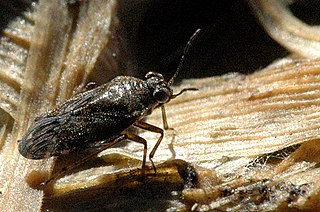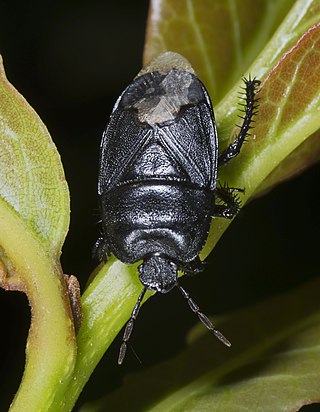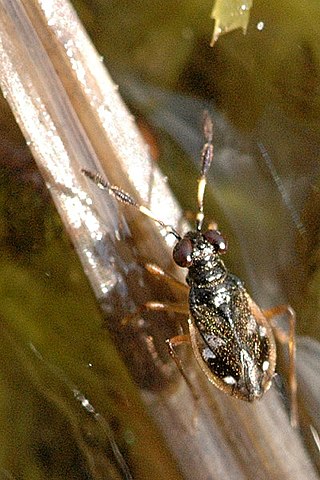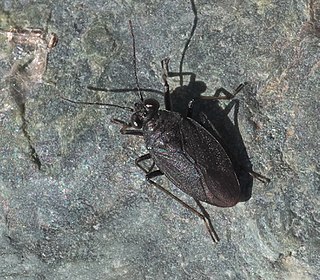
The Gelastocoridae is a family of about 100 species of insects in the suborder Heteroptera. These fall into two genera, about 15 species of Gelastocoris from the New World and 85 of Nerthra from the Old World. They are reminiscent of toads both in the warty appearance and hopping movements of some species.

Enicocephalidae, also called unique-headed bugs and gnat bugs, are a family of around 300 species of the suborder Heteroptera. They are typically 4 mm long, and found throughout the world. They have an elongated head, constricted in places, hence their head is 'unique'.

The Miridae are a large and diverse insect family at one time known by the taxonomic synonym Capsidae. Species in the family may be referred to as capsid bugs or "mirid bugs". Common names include plant bugs, leaf bugs, and grass bugs. It is the largest family of true bugs belonging to the suborder Heteroptera; it includes over 10,000 known species, and new ones are being described constantly. Most widely known mirids are species that are notorious agricultural pests that pierce plant tissues, feed on the sap, and sometimes transmit viral plant diseases. Some species however, are predatory.

Leptopodomorpha is an infraorder of insects in the order Hemiptera. Leptopodomorpha is an infraorder of the order Heteroptera that contains more than 380 species. These small insects are also called shore bugs, or spiny shore bugs. As their name suggests, shore bugs range from being intertidal, to living near streams and lakes. Four families belong to this infraorder, the largest of which is Saldidae with about 350 species, compared to about 30 in Leptopodidae, and only 5 and 1 in Omaniidae and Aepophilidae respectively. Saldidae are known in particular for their jumping ability.

Cydnidae are a family of pentatomoid bugs, known by common names including burrowing bugs or burrower bugs. As the common name would suggest, many members of the group live a subterranean lifestyle, burrowing into soil using their head and forelegs, only emerging to mate and then laying their eggs in soil. Other members of the group are not burrowers, and live above the soil layer, often in close association with plants. Several species are known as agricultural pests.

Saldidae, also known as shore bugs, are a family of insects in the order Hemiptera. They are oval-shaped and measure 2–8 mm (0.08–0.31 in) when mature. Typically they are found near shorelines or the marginal growths near freshwater bodies, estuaries, and sea coasts. They can flee by leaping or taking flight. There are about 350 recognized species with the majority from the Nearctic and Palearctic. Many species are found in the intertidal zone and both adults and nymphs of some species like Saldula pallipes can tolerate submergence at high-tide. Saldidae are predators and scavengers. They pass the winter through egg or adult diapause.

Yuri Alexandrovich Popov was a Soviet and Russian paleoentomologist, an authority on the taxonomy and evolution of fossil true bugs (Heteroptera) and Coleorrhyncha. He described more than 20 new families and subfamilies and 300 new genera and species from the Mesozoic and Cenozoic. He also was one of the founders of the modern higher classification of true bugs: three of seven heteropteran infraorders have been established by him. He was the author of more than 170 publications, including a classic monograph on the evolution of water bugs.

Schizopteridae is the largest family in the infraorder Dipsocoromorpha and comprises 56 genera and approximately 255 species. Schizopterids are some of the smallest (0.5–2.0 mm) true bugs. Members of this family can be distinguished by their small size, enlarged forecoxae and varying degree of abdominal and genitalic asymmetry in males. Schizopteridae exhibit a wide range of simple and complex wing venation patterns. The group is currently divided into three subfamilies: Schizopterinae, Ogeriinae and Hypselosomatinae.

Nerthra is a genus of toad bugs in the family Gelastocoridae. There are at least 90 described species in Nerthra.
Salda is a genus of shore bugs in the family Saldidae. There are about 18 described species in Salda.

Mesovelia is a genus of water treaders in the family Mesoveliidae. There are more than 30 described species in Mesovelia.

Mesoveliidae is a family of water treaders in the order Hemiptera. There are about 16 genera and at least 50 described species in Mesoveliidae.
Saldoida is a genus of shore bugs in the family Saldidae. There are about five described species in Saldoida.

Saldoidini is a tribe of shore bugs in the family Saldidae. There are more than 20 genera and 250 described species in Saldoidini.

Chiloxanthinae is a subfamily of shore bugs in the family Saldidae. There are about 7 genera and more than 20 described species in Chiloxanthinae.

Saldula is a genus of shore bugs in the family Saldidae. There are at least 120 described species in Saldula.

Hallodapini is a tribe of plant bugs in the family Miridae. There are more than 50 genera in Hallodapini.

Thaumastocoridae is a family of true bugs in the order Hemiptera. There are about 9 genera and more than 20 described species in the family Thaumastocoridae.
Colobathristidae is a family of true bugs in the order Hemiptera. There are more than 20 genera and 90 described species in Colobathristidae.
Yuripopovinidae is an extinct family of Coreoidea Hemipteran true bugs. Member species are known from the Early Cretaceous and early Late Cretaceous of Asia and northern Gondwana. Among the distinguishing characters are "the hemelytral costal vein apically much thickened and pterostigma-like, the corium with two large cells separated by one longitudinal straight vein." Dehiscensicoridae, described from the Yixian Formation of China has been deemed a junior synonym of Yuripopovinidae per Du et al. (2019). The family was named after Russian paleoentomologist Yuri Alexandrovich Popov.














